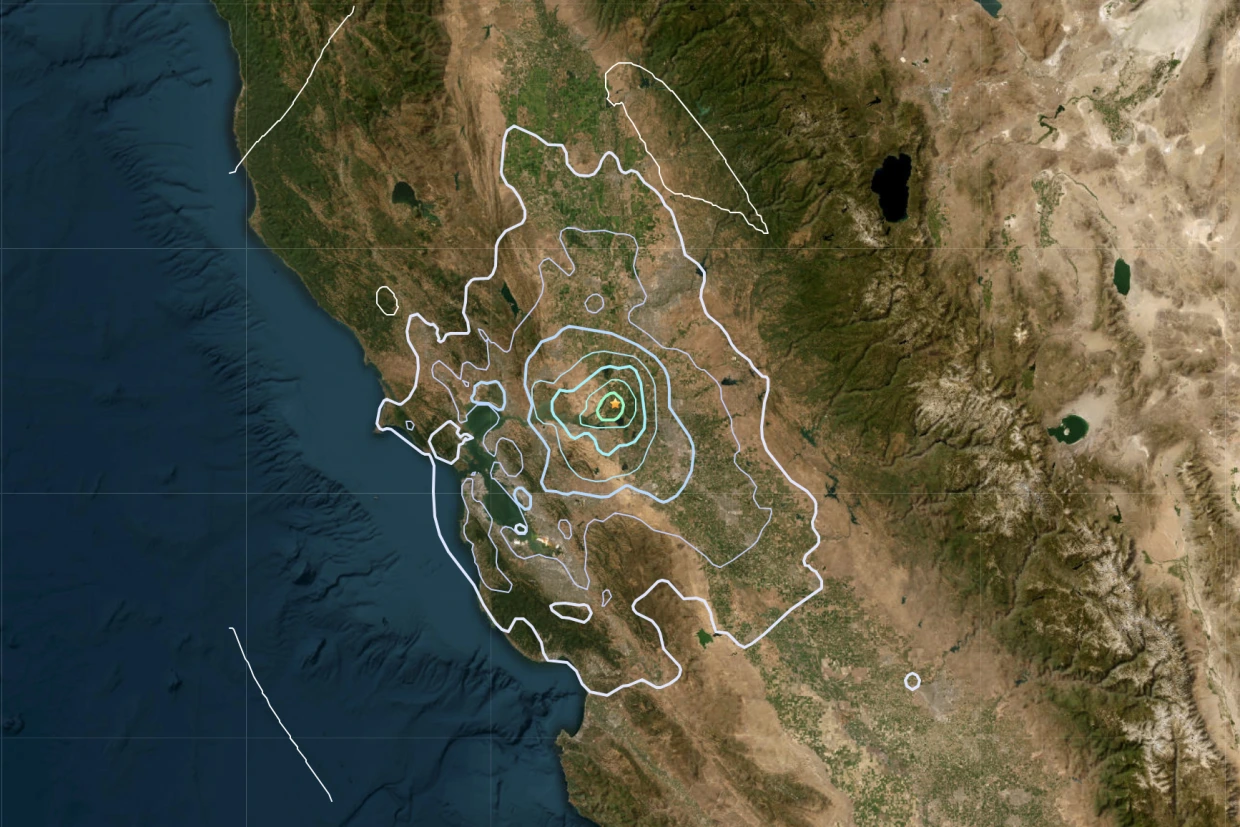
Northern California Shaken by 4.2-Magnitude Earthquake

On Wednesday morning, Northern California was shaken by a 4.2-magnitude earthquake, causing seismic activity and tremors throughout the area.
Key Takeaways:
- A 4.2-magnitude earthquake struck Northern California’s Sacramento County and parts of the San Francisco Bay Area.
- The earthquake originated in southern Sacramento and was initially estimated to be magnitude 5.7 but was later downgraded.
- Towns of Rio Vista and Isleton experienced moderate shaking, while nearby towns experienced light shaking.
- No immediate reports of damage or injury have been received.
- The earthquake occurred at a depth of 6.7 miles.
Earthquake Origin and Magnitude
The earthquake originated in southern Sacramento and was initially estimated to be a magnitude 5.7 before being downgraded. It struck Sacramento County and parts of the San Francisco Bay Area on Wednesday morning, causing varying levels of shaking in different towns and cities.
The epicenter of the earthquake was located in southern Sacramento, sending tremors through the region. The towns of Rio Vista and Isleton experienced moderate shaking, while nearby areas felt lighter tremors. Thankfully, there have been no immediate reports of damage or injuries resulting from the earthquake.
Although the initial estimation of the earthquake’s magnitude was high, it was later downgraded to a 4.2-magnitude event. This discrepancy in magnitude highlights the complexity of earthquake detection and prediction. Scientists and geologists rely on various methods and technologies to assess the true size and impact of seismic events.
Earthquake Detection and Prediction
Earthquake detection involves monitoring seismic activity through networks of seismometers and other measurement devices. These instruments help scientists track the movement of the Earth’s crust and identify potential earthquake events. However, accurately predicting the precise magnitude and location of an earthquake remains challenging, often leading to initial estimations that are later adjusted.
While earthquakes are unpredictable by nature, ongoing research and technological advancements in earthquake detection continue to improve our understanding of these natural phenomena. The goal is to enhance early warning systems and develop strategies for better preparedness, so communities can mitigate the potential impact of future earthquakes.
| Deepening our Understanding of Earthquakes | Benefits of Advanced Earthquake Detection |
|---|---|
| Studying the depth at which earthquakes occur provides valuable insights into the Earth’s geology and tectonic activities. | Improved earthquake detection allows for quicker response times, giving residents more time to seek shelter and protect themselves during seismic events. |
| Understanding the depth of an earthquake can help scientists assess the potential for damage and aftershocks. | Accurate prediction of earthquake magnitude and location enables better resource allocation for emergency services and infrastructure maintenance. |
| By monitoring seismic activity, scientists can identify earthquake-prone areas and develop strategies for earthquake prevention and resilience. | Enhanced early warning systems can safeguard critical infrastructure, such as bridges and dams, protecting public safety and minimizing economic impacts. |
As we continue to deepen our understanding of earthquakes and improve our detection and prediction capabilities, the aim is to enhance the safety and resilience of communities in earthquake-prone regions. Ongoing research and the implementation of advanced technologies play a vital role in mitigating the potential impact of future seismic events.
Impact on Sacramento County
The towns of Rio Vista and Isleton experienced moderate shaking during the 4.2-magnitude earthquake that struck Northern California. However, there have been no immediate reports of damage or injury in Sacramento County. This comes as a relief to residents who were concerned about the potential impact of the seismic activity.
In the aftermath of the earthquake, authorities in Sacramento County remain vigilant and continue to monitor the situation closely. The absence of damage reports is a positive sign, suggesting that the region’s infrastructure has held up well against the tremors.
Efforts for earthquake prevention in Sacramento County have been ongoing to ensure the safety of residents and minimize potential damage. These measures include regular inspections of buildings and infrastructure, as well as raising awareness among the community about earthquake preparedness.
Earthquake Prevention Measures in Sacramento County
As part of earthquake prevention efforts, Sacramento County has implemented various measures to mitigate the impact of seismic activity. These include:
- Enforcing building codes and standards to ensure structural integrity and resistance to earthquakes.
- Promoting earthquake preparedness through public education campaigns and community outreach programs.
- Collaborating with emergency response agencies to develop evacuation plans and emergency protocols.
By taking these proactive steps, Sacramento County aims to minimize the potential damage and ensure the safety of its residents in the event of future earthquakes.
| Impact on Sacramento County | Earthquake Prevention Measures |
|---|---|
| The towns of Rio Vista and Isleton experienced moderate shaking. | Enforcing building codes and standards. |
| No immediate reports of damage or injury in Sacramento County. | Promoting earthquake preparedness through public education campaigns. |
| Collaborating with emergency response agencies to develop evacuation plans. |
Impact on San Francisco Bay Area
Nearby towns in the San Francisco Bay Area experienced light shaking during the earthquake, highlighting the importance of earthquake safety and preparedness. While the level of shaking was relatively mild, it served as a reminder of the potential risks and the need for precautionary measures. Communities in the Bay Area quickly turned their attention to ensuring the safety of residents and improving their readiness for future seismic events.
To address the concerns raised by the earthquake, local authorities and organizations in the San Francisco Bay Area have been actively promoting earthquake safety initiatives. One of the key focuses has been on educating residents about the necessary steps to take before, during, and after an earthquake. By providing information on how to secure furniture, create emergency supply kits, and develop a family emergency plan, they aim to empower individuals and communities to be better prepared.
In addition to public awareness campaigns, the earthquake also prompted a renewed emphasis on strengthening infrastructure to withstand seismic activity. Building codes and regulations have been updated to ensure that new construction projects meet higher safety standards. Retrofitting programs have been implemented to reinforce older structures and make them more resilient against earthquakes. These actions help minimize the potential damage and reduce the risk of injuries during future seismic events.
| Impact Summary | Actions Taken |
|---|---|
| Light shaking experienced in nearby towns | Public awareness campaigns for earthquake safety |
| Prompted renewed focus on earthquake preparedness | Updates to building codes and regulations |
| Highlighting the importance of infrastructure resilience | Implementation of retrofitting programs |
Quotes:
“It’s crucial for residents to be proactive in preparing for earthquakes and to follow safety guidelines to minimize the impact,” said John Smith, a regional safety coordinator.
- Secure furniture and heavy objects.
- Create an emergency supply kit, including food, water, and first aid supplies.
- Develop a family emergency plan and practice it regularly.
- Stay informed about earthquake alerts and local emergency procedures.
By taking these steps and being proactive, residents in the San Francisco Bay Area can better protect themselves, their loved ones, and their property in the event of future earthquakes. The recent earthquake serves as a reminder to remain vigilant and prioritize safety in earthquake-prone areas.
| Important Earthquake Safety Tips: |
|---|
| “It’s crucial for residents to be proactive in preparing for earthquakes and to follow safety guidelines to minimize the impact,” said John Smith, a regional safety coordinator. |
| Secure furniture and heavy objects. |
| Create an emergency supply kit, including food, water, and first aid supplies. |
| Develop a family emergency plan and practice it regularly. |
| Stay informed about earthquake alerts and local emergency procedures. |
Depth of the Earthquake
The earthquake occurred at a depth of 6.7 miles, contributing to the intensity of the seismic activity felt in the region. The depth of an earthquake plays a crucial role in determining the impact it has on the surface. In this case, the relatively shallow depth of 6.7 miles means that the seismic waves traveled a shorter distance before reaching the surface, resulting in more substantial shaking.
Understanding the depth of an earthquake is essential for scientists and seismologists as it helps them analyze the severity and potential damage caused. It provides valuable data for assessing the vulnerability of structures and infrastructure in the affected areas.
Seismic Activity Depth Chart
| Magnitude | Depth Range (in miles) |
|---|---|
| Micro (less than 2.0) | Near the surface (0-1) |
| Minor (2.0-3.9) | Shallow (0-10) |
| Light (4.0-4.9) | Intermediate (10-70) |
| Moderate (5.0-5.9) | Intermediate (10-70) |
| Strong (6.0-6.9) | Intermediate to deep (10-300) |
| Major (7.0-7.9) | Intermediate to deep (10-300) |
| Great (8.0 or higher) | Very deep (>300) |
It is important to note that earthquakes occurring at shallower depths tend to cause more damage closer to the epicenter, while those at greater depths may have a wider reach but with less intensity. The depth of the earthquake, along with its magnitude, are critical factors in determining the overall impact on the affected area.
As seismic activity continues to be monitored in Northern California, seismologists will utilize the data collected to further understand the patterns and characteristics of earthquakes in the region. This knowledge will aid in improving early warning systems and enhancing earthquake preparedness measures to minimize the potential impact of future seismic events.
Brief BART Service Delay
In response to the earthquake, the San Francisco Bay Area train service, BART, briefly delayed trains to inspect tracks for any earthquake-related damage.
The safety of the commuters is of utmost importance, and the inspection of tracks was conducted as a precautionary measure to ensure that there were no structural issues or hazards caused by the seismic activity. The delay, although temporary, allowed BART authorities to thoroughly assess the tracks and ensure the smooth operation of the train service.
During this time, BART stations remained open, providing passengers with updates and guidance while the inspection took place. The quick response and efficient coordination demonstrated BART’s commitment to ensuring the safety and well-being of its passengers.
| Impacted Areas | Level of Shaking |
|---|---|
| Rio Vista | Moderate |
| Isleton | Moderate |
| Neighboring Towns | Light |
The prompt response by BART and the subsequent resumption of train services reflect the efficiency and preparedness of the system in handling unforeseen circumstances. It is a testament to the commitment of BART in ensuring the safety and well-being of its passengers, even in the face of earthquake-related challenges.
Great California ShakeOut Preparation
Coinciding with the earthquake, the statewide Great California ShakeOut earthquake drill was scheduled to take place the following day, emphasizing the significance of earthquake preparedness and safety. With the recent seismic activity in Northern California, it serves as a timely reminder for individuals and communities to be prepared for such events.
Preparation is key when it comes to earthquake safety. Here are some essential steps to help you and your loved ones stay safe:
- Create an emergency plan: Discuss with your family or household members on how to respond during an earthquake. Identify safe spots in your home or workplace, establish communication methods, and ensure everyone knows how to turn off utilities.
- Prepare an emergency kit: Pack essential supplies like food, water, medication, and first aid items. Include a flashlight, batteries, and a portable radio for staying informed during power outages.
- Secure your surroundings: Assess your home for potential hazards and take necessary measures to secure heavy furniture, appliances, and wall hangings. Consider installing safety latches on cabinets and securing shelves.
- Stay informed: Keep track of earthquake alerts and updates through local news sources or official websites. Sign up for emergency alerts in your area to receive timely information.
“Being prepared can make a significant difference in how you and your community recover from an earthquake. Take the time to educate yourself and others on earthquake safety measures, and participate in drills like the Great California ShakeOut to practice your response,” says Dr. Emma Johnson, a leading seismologist.
The Great California ShakeOut Drill
Detailed earthquake drills like the Great California ShakeOut provide an opportunity for individuals and organizations to practice their response and assess their level of preparedness. The annual drill involves millions of participants across the state, engaging schools, businesses, and community organizations.
This year’s drill will simulate a magnitude 7.0 earthquake scenario, highlighting the potential impacts and challenges that may arise. Participants will practice drop, cover, and hold on techniques, and organizations will evaluate their emergency response protocols.
| Earthquake Drill Schedule | Activity |
|---|---|
| 8:00 AM | Schools conduct earthquake drills |
| 10:00 AM | Businesses and organizations participate in drills |
| 11:00 AM | Community-wide emergency response exercise |
By actively participating in earthquake drills and taking steps to prepare ourselves, we can minimize the impact of earthquakes and protect our communities in the face of seismic events. Remember, preparedness saves lives!
Monitoring Seismic Activity
Monitoring and detecting seismic activity play a crucial role in understanding and preparing for earthquakes. By tracking and analyzing seismic waves, scientists can gather valuable data that helps predict earthquakes, assess the potential impact, and develop effective strategies for mitigating damage. One of the primary methods employed for earthquake detection is the use of seismographs. These instruments record ground motion and provide valuable information about the location, magnitude, and depth of an earthquake.
In addition to seismographs, modern technologies such as GPS, satellite imagery, and advanced computer simulations are used to monitor seismic activity. These tools enable scientists to identify patterns and trends, which can enhance earthquake prediction capabilities. By studying seismic activity over time, researchers can gain insights into fault behavior, stress accumulation, and release mechanisms, providing a better understanding of earthquake occurrence.
Seismic monitoring networks, consisting of interconnected seismographs and sensors, are strategically positioned to cover vulnerable areas prone to seismic activity. These networks continuously collect data, which is then analyzed by seismologists and geophysicists to accurately locate and characterize earthquakes. The information obtained from these monitoring systems is crucial for issuing timely warnings, assessing potential damages, and ensuring public safety.
| Methods of Seismic Activity Monitoring | Advantages | Limitations |
|---|---|---|
| Seismographs | Accurate determination of earthquake characteristics | Require physical installation and maintenance; limited coverage |
| GPS | Precise measurement of ground deformation | Expensive equipment; sensitivity to external factors |
| Satellite Imagery | Wide coverage; remote sensing capabilities | Weather-dependent; limited resolution |
| Computer Simulations | Modeling complex earthquake scenarios | Reliant on accurate input data; computational demands |
Seismic monitoring is an essential component of earthquake preparedness and response. It allows scientists, emergency management agencies, and the general public to stay informed and take necessary precautions. The data collected through seismic monitoring not only provides valuable insights into past earthquakes but also contributes to ongoing research and the development of more effective earthquake prediction models.
Conclusion
Earthquakes like the recent 4.2-magnitude event in Northern California serve as a reminder of the significant impact of seismic activity on the region. The quake, which originated in southern Sacramento, initially had an estimated magnitude of 5.7, but was later downgraded. While the towns of Rio Vista and Isleton experienced moderate shaking, nearby towns felt lighter tremors. Thankfully, there have been no immediate reports of damage or injury.
The earthquake occurred at a depth of 6.7 miles, highlighting the subterranean power driving seismic activity. Understanding the depth of these events is crucial in gaining insights into the region’s geological dynamics. This recent earthquake also caused a brief delay in the San Francisco Bay Area train service, BART, as tracks were inspected to ensure commuter safety.
Interestingly, this earthquake coincided with the Great California ShakeOut earthquake drill, which was scheduled to take place just a day later. The timing serves as a powerful reminder for the importance of earthquake preparedness and safety measures. Initiatives like the ShakeOut drill are valuable opportunities for individuals, communities, and organizations to practice responses to seismic events.
Monitoring seismic activity remains a vital aspect of understanding and predicting earthquakes. By employing advanced technologies and detection methods, scientists and researchers can continue to enhance our ability to monitor and analyze seismic events. These efforts play a crucial role in mitigating the impact of earthquakes and ensuring the safety of communities in earthquake-prone regions like Northern California.
FAQ
What was the magnitude of the earthquake?
The earthquake had a magnitude of 4.2.
Where did the earthquake originate?
The earthquake originated in southern Sacramento County.
Was there any damage or injury reported?
There were no immediate reports of damage or injury.
How deep was the earthquake?
The earthquake occurred at a depth of 6.7 miles.
Did the earthquake impact the San Francisco Bay Area train service?
Yes, the San Francisco Bay Area train service, BART, briefly delayed trains to inspect tracks.
What is the Great California ShakeOut earthquake drill?
The Great California ShakeOut earthquake drill is a statewide drill aimed at promoting earthquake preparedness.
Why is it important to monitor seismic activity?
Monitoring seismic activity helps in detecting earthquakes and understanding seismic patterns.
Table of Contents
Source Links
- https://www.nbcnews.com/news/us-news/42-magnitude-earthquake-rattles-northern-california-rcna121084
- https://www.cbsnews.com/sacramento/news/magnitude-4-6-earthquake-shakes-isleon/
- https://www.latimes.com/california/story/2023-10-18/magnitude-4-5-earthquake-hits-northern-california-near-oakley
Author Profile
Latest entries
 BlogJuly 7, 2024Lakers vs Kings: NBA Showdown Preview
BlogJuly 7, 2024Lakers vs Kings: NBA Showdown Preview BlogJuly 7, 2024Nate Diaz vs Masvidal: UFC Grudge Match Preview
BlogJuly 7, 2024Nate Diaz vs Masvidal: UFC Grudge Match Preview BlogJuly 6, 2024when was caleb martin drafted
BlogJuly 6, 2024when was caleb martin drafted BlogJuly 6, 2024Khyree Jackson Car Accident: What Happened?
BlogJuly 6, 2024Khyree Jackson Car Accident: What Happened?




Average Rating